Business Law: Analysis of Negligence and Misrepresentation Torts
VerifiedAdded on 2020/02/18
|11
|2971
|61
Essay
AI Summary
This essay provides a comprehensive overview of business law, specifically focusing on the torts of negligence and misrepresentation. It outlines the legal components of each tort, including duty of care, breach of duty, and misrepresentation of material facts. The essay uses real-life business scenarios to illustrate how these torts manifest, such as in cases of HR negligence or misleading product claims. It also details the steps required to prove these torts, the care businesses should take when advising customers, and the potential consequences of such actions. Furthermore, the essay explores defenses available to businesses, like contributory negligence and assumption of risk, and examines the role of statutory authorities, such as the ACCC, in protecting public interests. The essay concludes by discussing the actions affected consumers can take against businesses and what they can expect to gain from those actions. This essay provides insights into business law and is a valuable resource for students on Desklib.
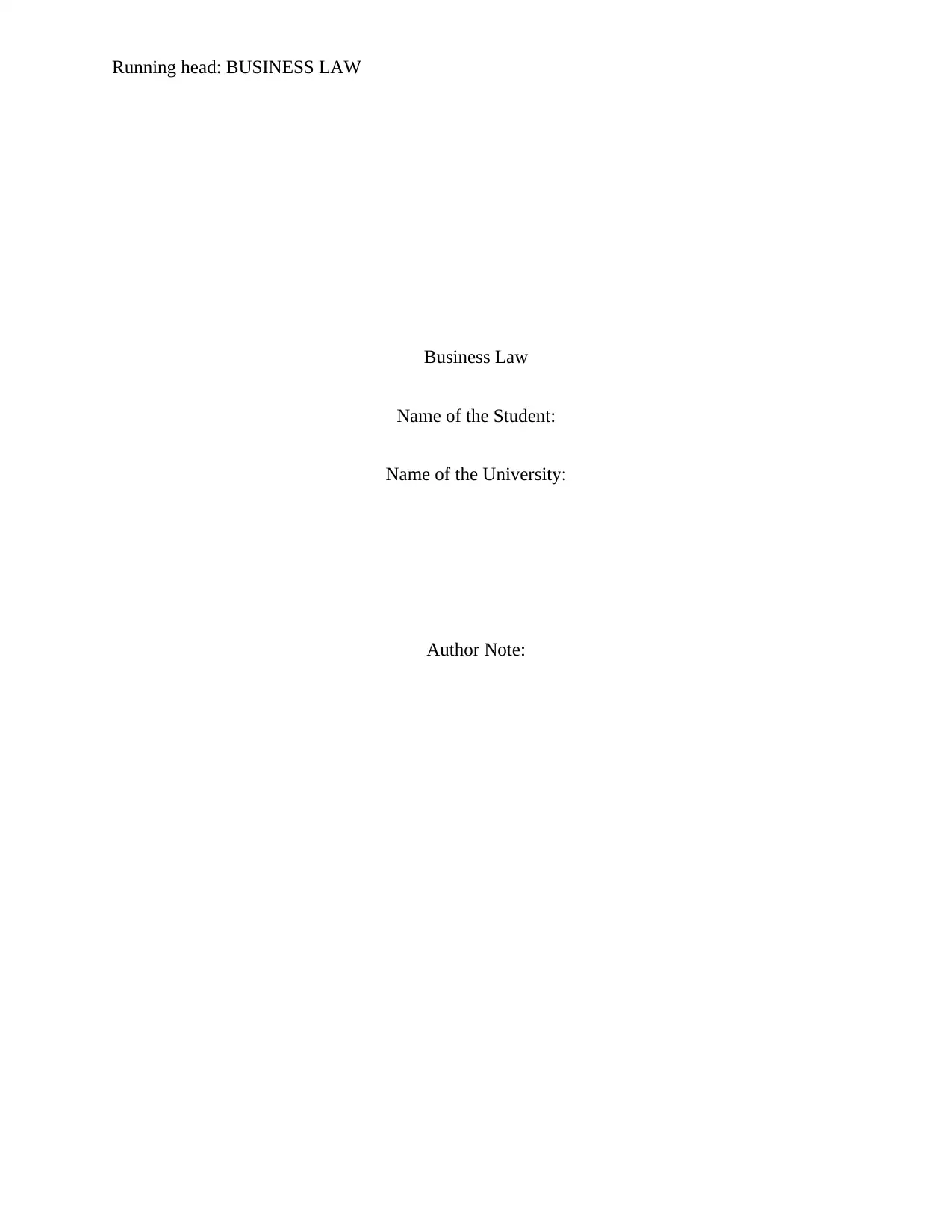
Running head: BUSINESS LAW
Business Law
Name of the Student:
Name of the University:
Author Note:
Business Law
Name of the Student:
Name of the University:
Author Note:
Paraphrase This Document
Need a fresh take? Get an instant paraphrase of this document with our AI Paraphraser
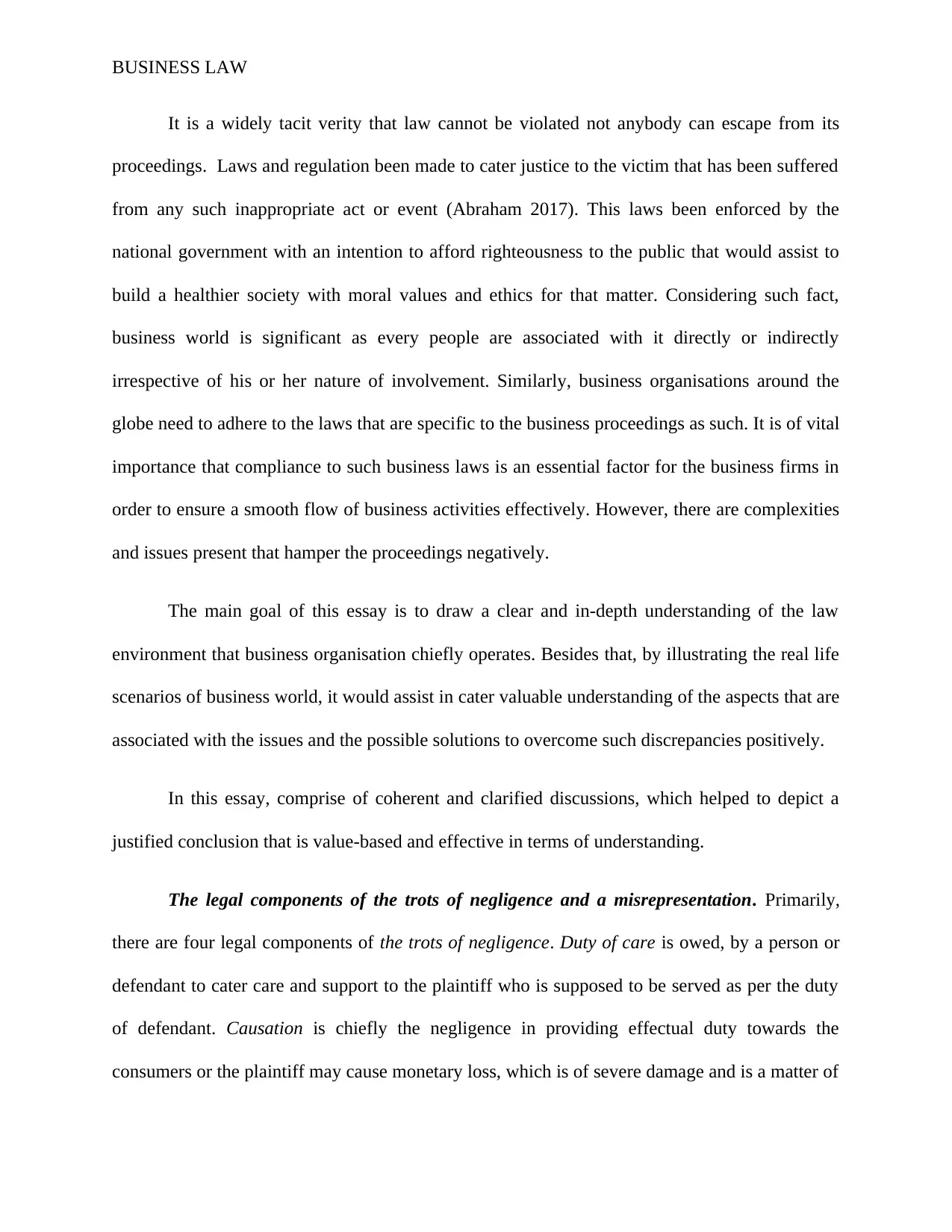
BUSINESS LAW
It is a widely tacit verity that law cannot be violated not anybody can escape from its
proceedings. Laws and regulation been made to cater justice to the victim that has been suffered
from any such inappropriate act or event (Abraham 2017). This laws been enforced by the
national government with an intention to afford righteousness to the public that would assist to
build a healthier society with moral values and ethics for that matter. Considering such fact,
business world is significant as every people are associated with it directly or indirectly
irrespective of his or her nature of involvement. Similarly, business organisations around the
globe need to adhere to the laws that are specific to the business proceedings as such. It is of vital
importance that compliance to such business laws is an essential factor for the business firms in
order to ensure a smooth flow of business activities effectively. However, there are complexities
and issues present that hamper the proceedings negatively.
The main goal of this essay is to draw a clear and in-depth understanding of the law
environment that business organisation chiefly operates. Besides that, by illustrating the real life
scenarios of business world, it would assist in cater valuable understanding of the aspects that are
associated with the issues and the possible solutions to overcome such discrepancies positively.
In this essay, comprise of coherent and clarified discussions, which helped to depict a
justified conclusion that is value-based and effective in terms of understanding.
The legal components of the trots of negligence and a misrepresentation. Primarily,
there are four legal components of the trots of negligence. Duty of care is owed, by a person or
defendant to cater care and support to the plaintiff who is supposed to be served as per the duty
of defendant. Causation is chiefly the negligence in providing effectual duty towards the
consumers or the plaintiff may cause monetary loss, which is of severe damage and is a matter of
It is a widely tacit verity that law cannot be violated not anybody can escape from its
proceedings. Laws and regulation been made to cater justice to the victim that has been suffered
from any such inappropriate act or event (Abraham 2017). This laws been enforced by the
national government with an intention to afford righteousness to the public that would assist to
build a healthier society with moral values and ethics for that matter. Considering such fact,
business world is significant as every people are associated with it directly or indirectly
irrespective of his or her nature of involvement. Similarly, business organisations around the
globe need to adhere to the laws that are specific to the business proceedings as such. It is of vital
importance that compliance to such business laws is an essential factor for the business firms in
order to ensure a smooth flow of business activities effectively. However, there are complexities
and issues present that hamper the proceedings negatively.
The main goal of this essay is to draw a clear and in-depth understanding of the law
environment that business organisation chiefly operates. Besides that, by illustrating the real life
scenarios of business world, it would assist in cater valuable understanding of the aspects that are
associated with the issues and the possible solutions to overcome such discrepancies positively.
In this essay, comprise of coherent and clarified discussions, which helped to depict a
justified conclusion that is value-based and effective in terms of understanding.
The legal components of the trots of negligence and a misrepresentation. Primarily,
there are four legal components of the trots of negligence. Duty of care is owed, by a person or
defendant to cater care and support to the plaintiff who is supposed to be served as per the duty
of defendant. Causation is chiefly the negligence in providing effectual duty towards the
consumers or the plaintiff may cause monetary loss, which is of severe damage and is a matter of
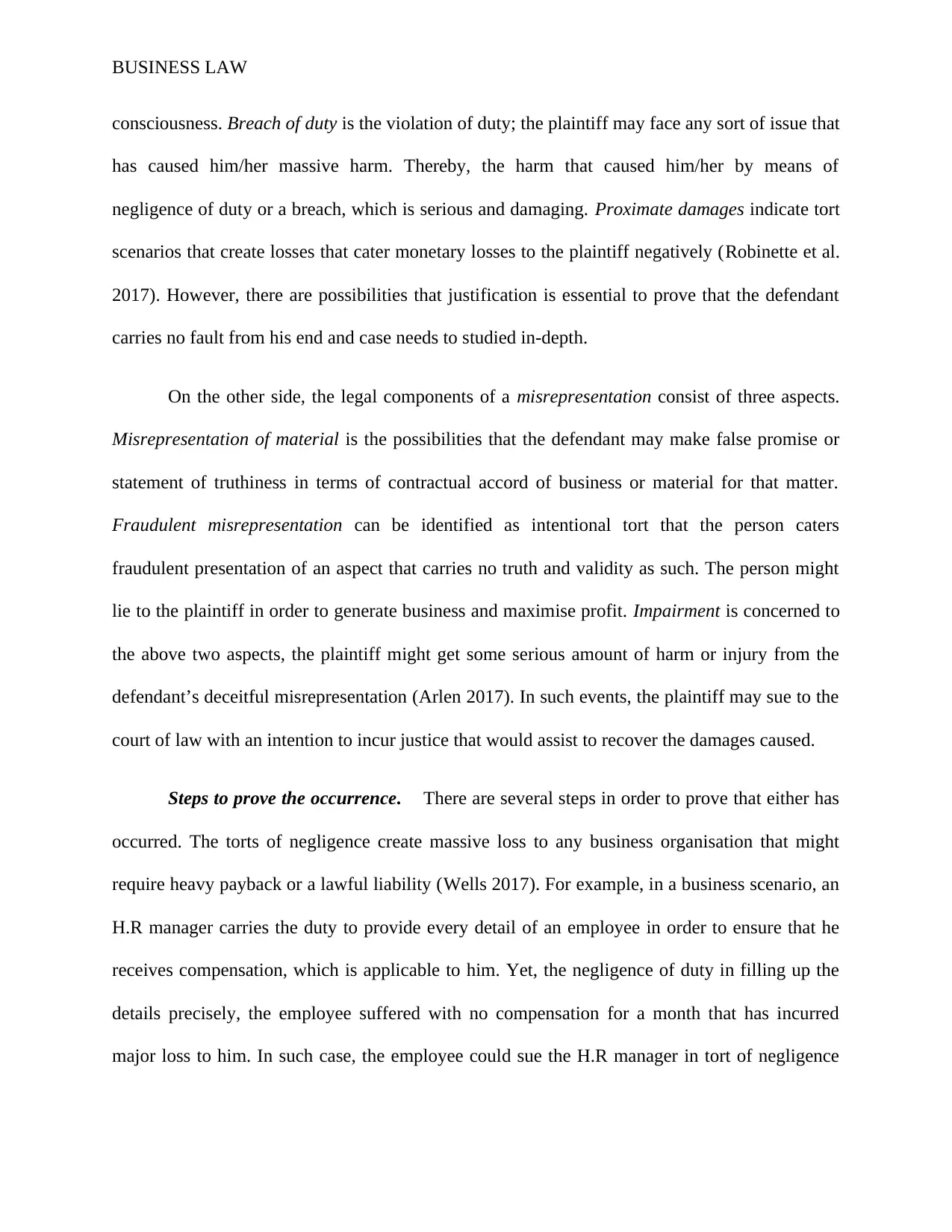
BUSINESS LAW
consciousness. Breach of duty is the violation of duty; the plaintiff may face any sort of issue that
has caused him/her massive harm. Thereby, the harm that caused him/her by means of
negligence of duty or a breach, which is serious and damaging. Proximate damages indicate tort
scenarios that create losses that cater monetary losses to the plaintiff negatively (Robinette et al.
2017). However, there are possibilities that justification is essential to prove that the defendant
carries no fault from his end and case needs to studied in-depth.
On the other side, the legal components of a misrepresentation consist of three aspects.
Misrepresentation of material is the possibilities that the defendant may make false promise or
statement of truthiness in terms of contractual accord of business or material for that matter.
Fraudulent misrepresentation can be identified as intentional tort that the person caters
fraudulent presentation of an aspect that carries no truth and validity as such. The person might
lie to the plaintiff in order to generate business and maximise profit. Impairment is concerned to
the above two aspects, the plaintiff might get some serious amount of harm or injury from the
defendant’s deceitful misrepresentation (Arlen 2017). In such events, the plaintiff may sue to the
court of law with an intention to incur justice that would assist to recover the damages caused.
Steps to prove the occurrence. There are several steps in order to prove that either has
occurred. The torts of negligence create massive loss to any business organisation that might
require heavy payback or a lawful liability (Wells 2017). For example, in a business scenario, an
H.R manager carries the duty to provide every detail of an employee in order to ensure that he
receives compensation, which is applicable to him. Yet, the negligence of duty in filling up the
details precisely, the employee suffered with no compensation for a month that has incurred
major loss to him. In such case, the employee could sue the H.R manager in tort of negligence
consciousness. Breach of duty is the violation of duty; the plaintiff may face any sort of issue that
has caused him/her massive harm. Thereby, the harm that caused him/her by means of
negligence of duty or a breach, which is serious and damaging. Proximate damages indicate tort
scenarios that create losses that cater monetary losses to the plaintiff negatively (Robinette et al.
2017). However, there are possibilities that justification is essential to prove that the defendant
carries no fault from his end and case needs to studied in-depth.
On the other side, the legal components of a misrepresentation consist of three aspects.
Misrepresentation of material is the possibilities that the defendant may make false promise or
statement of truthiness in terms of contractual accord of business or material for that matter.
Fraudulent misrepresentation can be identified as intentional tort that the person caters
fraudulent presentation of an aspect that carries no truth and validity as such. The person might
lie to the plaintiff in order to generate business and maximise profit. Impairment is concerned to
the above two aspects, the plaintiff might get some serious amount of harm or injury from the
defendant’s deceitful misrepresentation (Arlen 2017). In such events, the plaintiff may sue to the
court of law with an intention to incur justice that would assist to recover the damages caused.
Steps to prove the occurrence. There are several steps in order to prove that either has
occurred. The torts of negligence create massive loss to any business organisation that might
require heavy payback or a lawful liability (Wells 2017). For example, in a business scenario, an
H.R manager carries the duty to provide every detail of an employee in order to ensure that he
receives compensation, which is applicable to him. Yet, the negligence of duty in filling up the
details precisely, the employee suffered with no compensation for a month that has incurred
major loss to him. In such case, the employee could sue the H.R manager in tort of negligence
⊘ This is a preview!⊘
Do you want full access?
Subscribe today to unlock all pages.

Trusted by 1+ million students worldwide
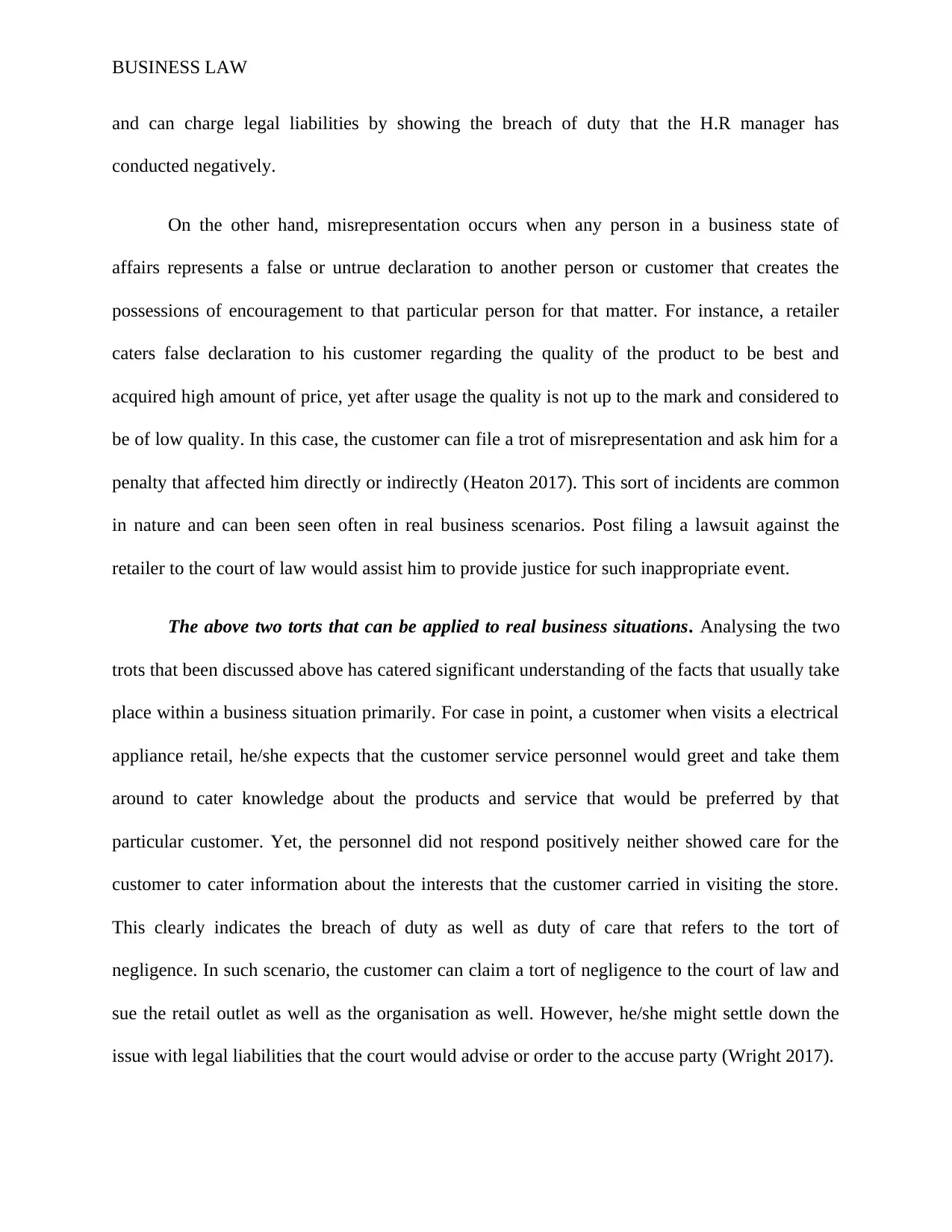
BUSINESS LAW
and can charge legal liabilities by showing the breach of duty that the H.R manager has
conducted negatively.
On the other hand, misrepresentation occurs when any person in a business state of
affairs represents a false or untrue declaration to another person or customer that creates the
possessions of encouragement to that particular person for that matter. For instance, a retailer
caters false declaration to his customer regarding the quality of the product to be best and
acquired high amount of price, yet after usage the quality is not up to the mark and considered to
be of low quality. In this case, the customer can file a trot of misrepresentation and ask him for a
penalty that affected him directly or indirectly (Heaton 2017). This sort of incidents are common
in nature and can been seen often in real business scenarios. Post filing a lawsuit against the
retailer to the court of law would assist him to provide justice for such inappropriate event.
The above two torts that can be applied to real business situations. Analysing the two
trots that been discussed above has catered significant understanding of the facts that usually take
place within a business situation primarily. For case in point, a customer when visits a electrical
appliance retail, he/she expects that the customer service personnel would greet and take them
around to cater knowledge about the products and service that would be preferred by that
particular customer. Yet, the personnel did not respond positively neither showed care for the
customer to cater information about the interests that the customer carried in visiting the store.
This clearly indicates the breach of duty as well as duty of care that refers to the tort of
negligence. In such scenario, the customer can claim a tort of negligence to the court of law and
sue the retail outlet as well as the organisation as well. However, he/she might settle down the
issue with legal liabilities that the court would advise or order to the accuse party (Wright 2017).
and can charge legal liabilities by showing the breach of duty that the H.R manager has
conducted negatively.
On the other hand, misrepresentation occurs when any person in a business state of
affairs represents a false or untrue declaration to another person or customer that creates the
possessions of encouragement to that particular person for that matter. For instance, a retailer
caters false declaration to his customer regarding the quality of the product to be best and
acquired high amount of price, yet after usage the quality is not up to the mark and considered to
be of low quality. In this case, the customer can file a trot of misrepresentation and ask him for a
penalty that affected him directly or indirectly (Heaton 2017). This sort of incidents are common
in nature and can been seen often in real business scenarios. Post filing a lawsuit against the
retailer to the court of law would assist him to provide justice for such inappropriate event.
The above two torts that can be applied to real business situations. Analysing the two
trots that been discussed above has catered significant understanding of the facts that usually take
place within a business situation primarily. For case in point, a customer when visits a electrical
appliance retail, he/she expects that the customer service personnel would greet and take them
around to cater knowledge about the products and service that would be preferred by that
particular customer. Yet, the personnel did not respond positively neither showed care for the
customer to cater information about the interests that the customer carried in visiting the store.
This clearly indicates the breach of duty as well as duty of care that refers to the tort of
negligence. In such scenario, the customer can claim a tort of negligence to the court of law and
sue the retail outlet as well as the organisation as well. However, he/she might settle down the
issue with legal liabilities that the court would advise or order to the accuse party (Wright 2017).
Paraphrase This Document
Need a fresh take? Get an instant paraphrase of this document with our AI Paraphraser
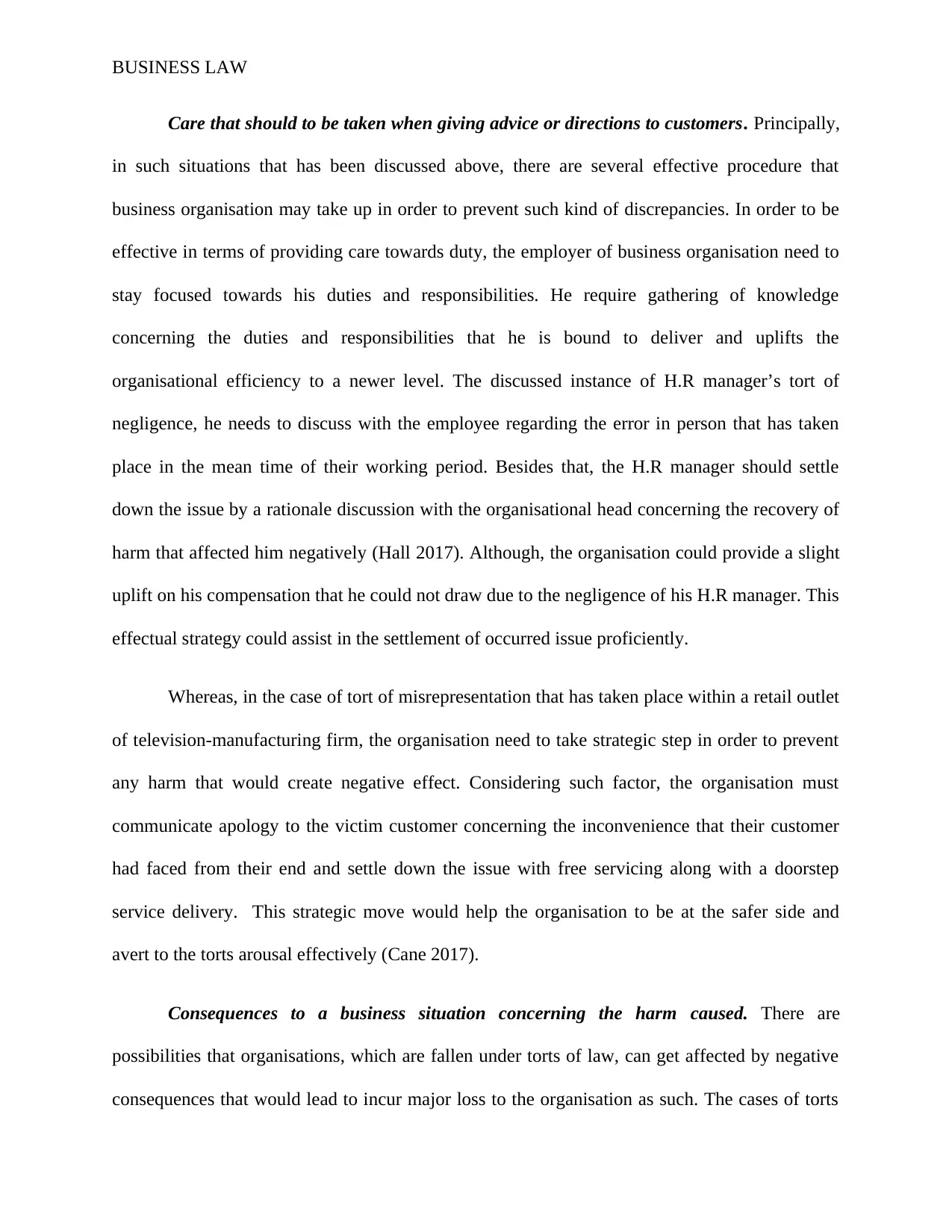
BUSINESS LAW
Care that should to be taken when giving advice or directions to customers. Principally,
in such situations that has been discussed above, there are several effective procedure that
business organisation may take up in order to prevent such kind of discrepancies. In order to be
effective in terms of providing care towards duty, the employer of business organisation need to
stay focused towards his duties and responsibilities. He require gathering of knowledge
concerning the duties and responsibilities that he is bound to deliver and uplifts the
organisational efficiency to a newer level. The discussed instance of H.R manager’s tort of
negligence, he needs to discuss with the employee regarding the error in person that has taken
place in the mean time of their working period. Besides that, the H.R manager should settle
down the issue by a rationale discussion with the organisational head concerning the recovery of
harm that affected him negatively (Hall 2017). Although, the organisation could provide a slight
uplift on his compensation that he could not draw due to the negligence of his H.R manager. This
effectual strategy could assist in the settlement of occurred issue proficiently.
Whereas, in the case of tort of misrepresentation that has taken place within a retail outlet
of television-manufacturing firm, the organisation need to take strategic step in order to prevent
any harm that would create negative effect. Considering such factor, the organisation must
communicate apology to the victim customer concerning the inconvenience that their customer
had faced from their end and settle down the issue with free servicing along with a doorstep
service delivery. This strategic move would help the organisation to be at the safer side and
avert to the torts arousal effectively (Cane 2017).
Consequences to a business situation concerning the harm caused. There are
possibilities that organisations, which are fallen under torts of law, can get affected by negative
consequences that would lead to incur major loss to the organisation as such. The cases of torts
Care that should to be taken when giving advice or directions to customers. Principally,
in such situations that has been discussed above, there are several effective procedure that
business organisation may take up in order to prevent such kind of discrepancies. In order to be
effective in terms of providing care towards duty, the employer of business organisation need to
stay focused towards his duties and responsibilities. He require gathering of knowledge
concerning the duties and responsibilities that he is bound to deliver and uplifts the
organisational efficiency to a newer level. The discussed instance of H.R manager’s tort of
negligence, he needs to discuss with the employee regarding the error in person that has taken
place in the mean time of their working period. Besides that, the H.R manager should settle
down the issue by a rationale discussion with the organisational head concerning the recovery of
harm that affected him negatively (Hall 2017). Although, the organisation could provide a slight
uplift on his compensation that he could not draw due to the negligence of his H.R manager. This
effectual strategy could assist in the settlement of occurred issue proficiently.
Whereas, in the case of tort of misrepresentation that has taken place within a retail outlet
of television-manufacturing firm, the organisation need to take strategic step in order to prevent
any harm that would create negative effect. Considering such factor, the organisation must
communicate apology to the victim customer concerning the inconvenience that their customer
had faced from their end and settle down the issue with free servicing along with a doorstep
service delivery. This strategic move would help the organisation to be at the safer side and
avert to the torts arousal effectively (Cane 2017).
Consequences to a business situation concerning the harm caused. There are
possibilities that organisations, which are fallen under torts of law, can get affected by negative
consequences that would lead to incur major loss to the organisation as such. The cases of torts
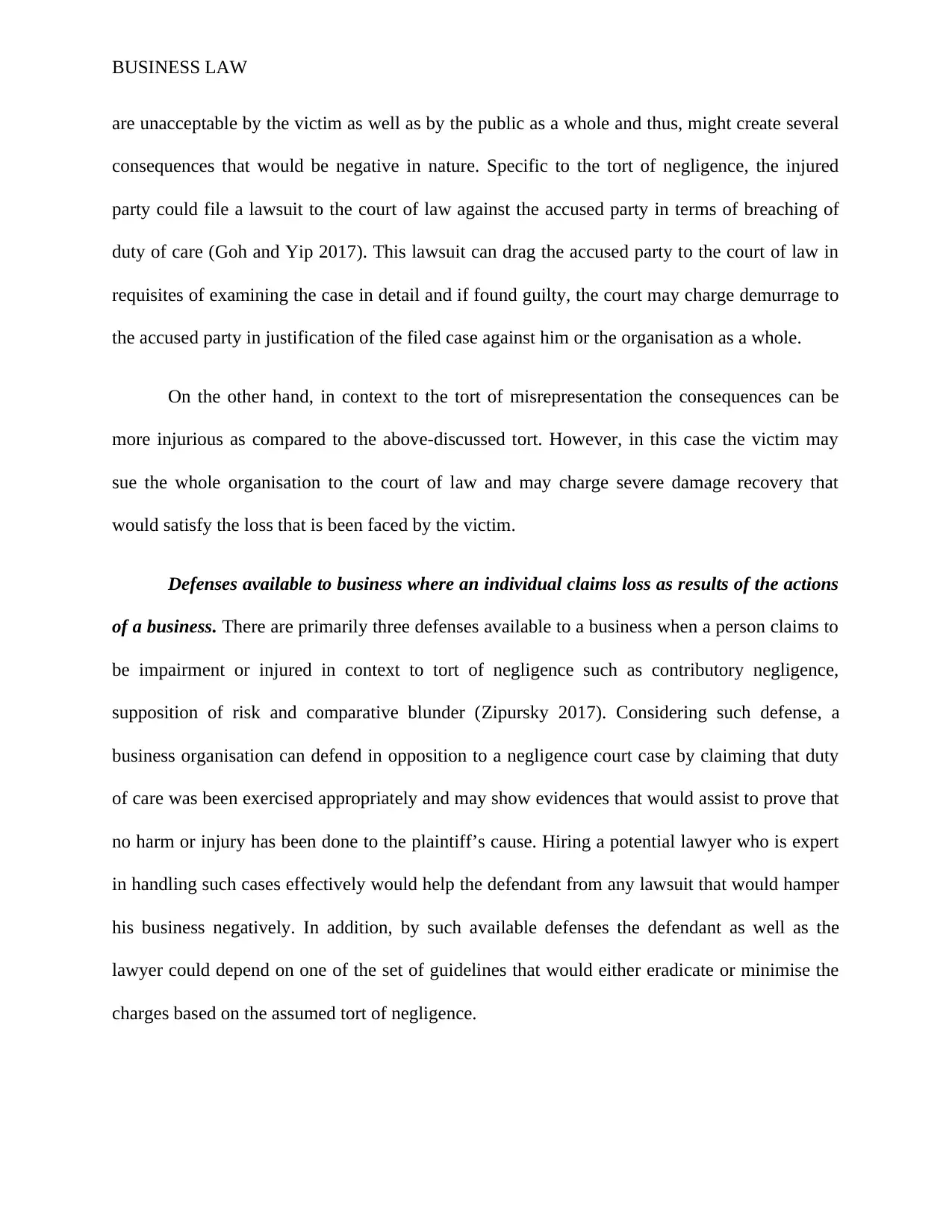
BUSINESS LAW
are unacceptable by the victim as well as by the public as a whole and thus, might create several
consequences that would be negative in nature. Specific to the tort of negligence, the injured
party could file a lawsuit to the court of law against the accused party in terms of breaching of
duty of care (Goh and Yip 2017). This lawsuit can drag the accused party to the court of law in
requisites of examining the case in detail and if found guilty, the court may charge demurrage to
the accused party in justification of the filed case against him or the organisation as a whole.
On the other hand, in context to the tort of misrepresentation the consequences can be
more injurious as compared to the above-discussed tort. However, in this case the victim may
sue the whole organisation to the court of law and may charge severe damage recovery that
would satisfy the loss that is been faced by the victim.
Defenses available to business where an individual claims loss as results of the actions
of a business. There are primarily three defenses available to a business when a person claims to
be impairment or injured in context to tort of negligence such as contributory negligence,
supposition of risk and comparative blunder (Zipursky 2017). Considering such defense, a
business organisation can defend in opposition to a negligence court case by claiming that duty
of care was been exercised appropriately and may show evidences that would assist to prove that
no harm or injury has been done to the plaintiff’s cause. Hiring a potential lawyer who is expert
in handling such cases effectively would help the defendant from any lawsuit that would hamper
his business negatively. In addition, by such available defenses the defendant as well as the
lawyer could depend on one of the set of guidelines that would either eradicate or minimise the
charges based on the assumed tort of negligence.
are unacceptable by the victim as well as by the public as a whole and thus, might create several
consequences that would be negative in nature. Specific to the tort of negligence, the injured
party could file a lawsuit to the court of law against the accused party in terms of breaching of
duty of care (Goh and Yip 2017). This lawsuit can drag the accused party to the court of law in
requisites of examining the case in detail and if found guilty, the court may charge demurrage to
the accused party in justification of the filed case against him or the organisation as a whole.
On the other hand, in context to the tort of misrepresentation the consequences can be
more injurious as compared to the above-discussed tort. However, in this case the victim may
sue the whole organisation to the court of law and may charge severe damage recovery that
would satisfy the loss that is been faced by the victim.
Defenses available to business where an individual claims loss as results of the actions
of a business. There are primarily three defenses available to a business when a person claims to
be impairment or injured in context to tort of negligence such as contributory negligence,
supposition of risk and comparative blunder (Zipursky 2017). Considering such defense, a
business organisation can defend in opposition to a negligence court case by claiming that duty
of care was been exercised appropriately and may show evidences that would assist to prove that
no harm or injury has been done to the plaintiff’s cause. Hiring a potential lawyer who is expert
in handling such cases effectively would help the defendant from any lawsuit that would hamper
his business negatively. In addition, by such available defenses the defendant as well as the
lawyer could depend on one of the set of guidelines that would either eradicate or minimise the
charges based on the assumed tort of negligence.
⊘ This is a preview!⊘
Do you want full access?
Subscribe today to unlock all pages.

Trusted by 1+ million students worldwide
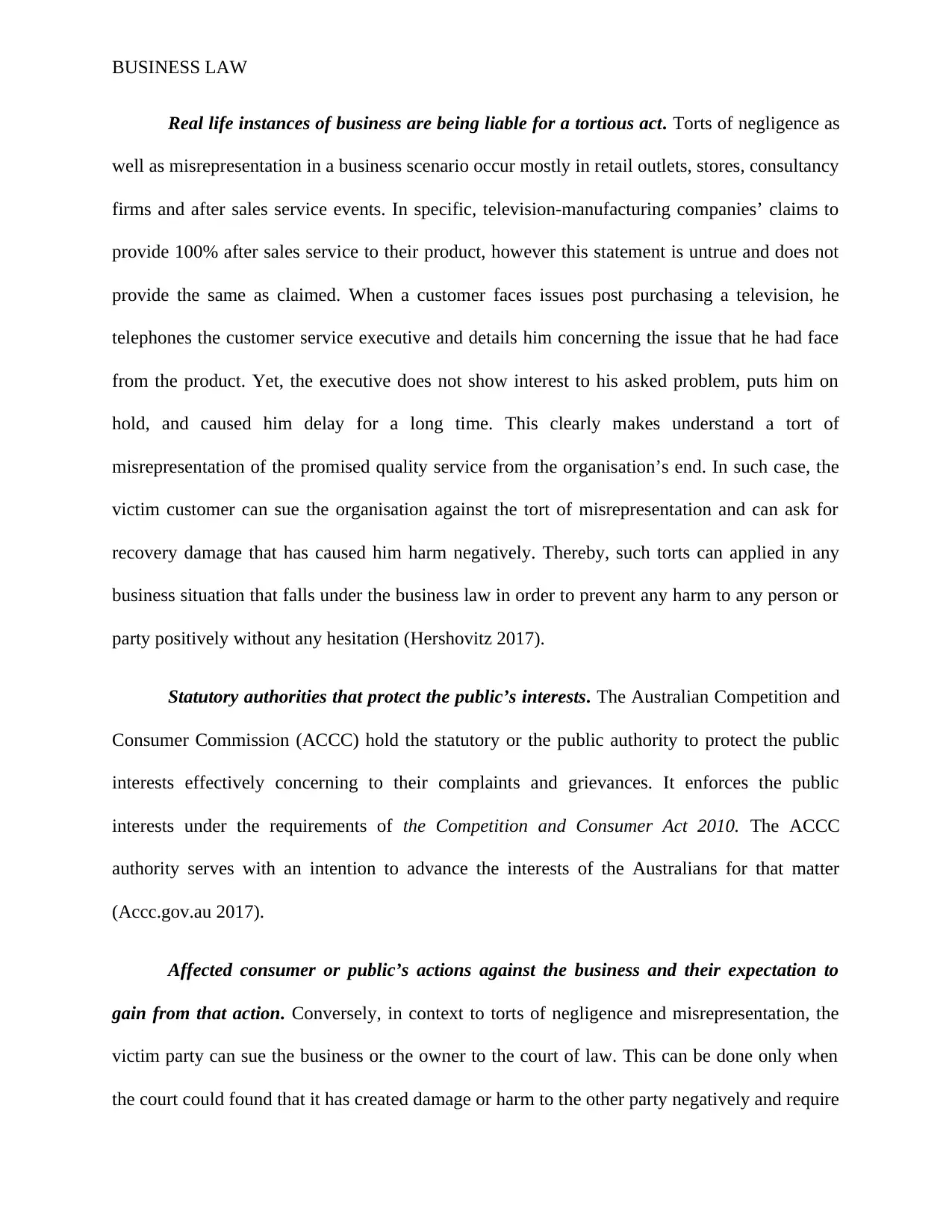
BUSINESS LAW
Real life instances of business are being liable for a tortious act. Torts of negligence as
well as misrepresentation in a business scenario occur mostly in retail outlets, stores, consultancy
firms and after sales service events. In specific, television-manufacturing companies’ claims to
provide 100% after sales service to their product, however this statement is untrue and does not
provide the same as claimed. When a customer faces issues post purchasing a television, he
telephones the customer service executive and details him concerning the issue that he had face
from the product. Yet, the executive does not show interest to his asked problem, puts him on
hold, and caused him delay for a long time. This clearly makes understand a tort of
misrepresentation of the promised quality service from the organisation’s end. In such case, the
victim customer can sue the organisation against the tort of misrepresentation and can ask for
recovery damage that has caused him harm negatively. Thereby, such torts can applied in any
business situation that falls under the business law in order to prevent any harm to any person or
party positively without any hesitation (Hershovitz 2017).
Statutory authorities that protect the public’s interests. The Australian Competition and
Consumer Commission (ACCC) hold the statutory or the public authority to protect the public
interests effectively concerning to their complaints and grievances. It enforces the public
interests under the requirements of the Competition and Consumer Act 2010. The ACCC
authority serves with an intention to advance the interests of the Australians for that matter
(Accc.gov.au 2017).
Affected consumer or public’s actions against the business and their expectation to
gain from that action. Conversely, in context to torts of negligence and misrepresentation, the
victim party can sue the business or the owner to the court of law. This can be done only when
the court could found that it has created damage or harm to the other party negatively and require
Real life instances of business are being liable for a tortious act. Torts of negligence as
well as misrepresentation in a business scenario occur mostly in retail outlets, stores, consultancy
firms and after sales service events. In specific, television-manufacturing companies’ claims to
provide 100% after sales service to their product, however this statement is untrue and does not
provide the same as claimed. When a customer faces issues post purchasing a television, he
telephones the customer service executive and details him concerning the issue that he had face
from the product. Yet, the executive does not show interest to his asked problem, puts him on
hold, and caused him delay for a long time. This clearly makes understand a tort of
misrepresentation of the promised quality service from the organisation’s end. In such case, the
victim customer can sue the organisation against the tort of misrepresentation and can ask for
recovery damage that has caused him harm negatively. Thereby, such torts can applied in any
business situation that falls under the business law in order to prevent any harm to any person or
party positively without any hesitation (Hershovitz 2017).
Statutory authorities that protect the public’s interests. The Australian Competition and
Consumer Commission (ACCC) hold the statutory or the public authority to protect the public
interests effectively concerning to their complaints and grievances. It enforces the public
interests under the requirements of the Competition and Consumer Act 2010. The ACCC
authority serves with an intention to advance the interests of the Australians for that matter
(Accc.gov.au 2017).
Affected consumer or public’s actions against the business and their expectation to
gain from that action. Conversely, in context to torts of negligence and misrepresentation, the
victim party can sue the business or the owner to the court of law. This can be done only when
the court could found that it has created damage or harm to the other party negatively and require
Paraphrase This Document
Need a fresh take? Get an instant paraphrase of this document with our AI Paraphraser
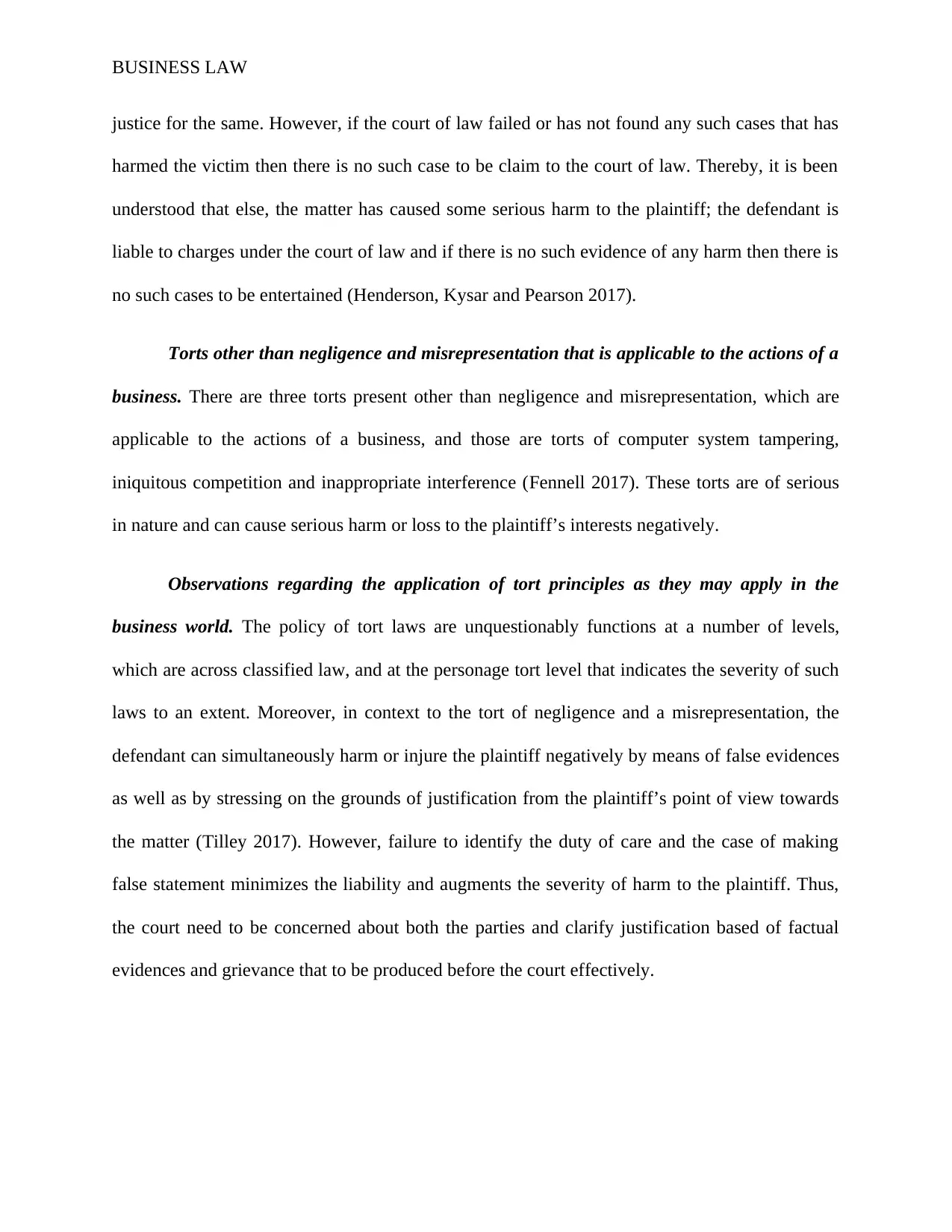
BUSINESS LAW
justice for the same. However, if the court of law failed or has not found any such cases that has
harmed the victim then there is no such case to be claim to the court of law. Thereby, it is been
understood that else, the matter has caused some serious harm to the plaintiff; the defendant is
liable to charges under the court of law and if there is no such evidence of any harm then there is
no such cases to be entertained (Henderson, Kysar and Pearson 2017).
Torts other than negligence and misrepresentation that is applicable to the actions of a
business. There are three torts present other than negligence and misrepresentation, which are
applicable to the actions of a business, and those are torts of computer system tampering,
iniquitous competition and inappropriate interference (Fennell 2017). These torts are of serious
in nature and can cause serious harm or loss to the plaintiff’s interests negatively.
Observations regarding the application of tort principles as they may apply in the
business world. The policy of tort laws are unquestionably functions at a number of levels,
which are across classified law, and at the personage tort level that indicates the severity of such
laws to an extent. Moreover, in context to the tort of negligence and a misrepresentation, the
defendant can simultaneously harm or injure the plaintiff negatively by means of false evidences
as well as by stressing on the grounds of justification from the plaintiff’s point of view towards
the matter (Tilley 2017). However, failure to identify the duty of care and the case of making
false statement minimizes the liability and augments the severity of harm to the plaintiff. Thus,
the court need to be concerned about both the parties and clarify justification based of factual
evidences and grievance that to be produced before the court effectively.
justice for the same. However, if the court of law failed or has not found any such cases that has
harmed the victim then there is no such case to be claim to the court of law. Thereby, it is been
understood that else, the matter has caused some serious harm to the plaintiff; the defendant is
liable to charges under the court of law and if there is no such evidence of any harm then there is
no such cases to be entertained (Henderson, Kysar and Pearson 2017).
Torts other than negligence and misrepresentation that is applicable to the actions of a
business. There are three torts present other than negligence and misrepresentation, which are
applicable to the actions of a business, and those are torts of computer system tampering,
iniquitous competition and inappropriate interference (Fennell 2017). These torts are of serious
in nature and can cause serious harm or loss to the plaintiff’s interests negatively.
Observations regarding the application of tort principles as they may apply in the
business world. The policy of tort laws are unquestionably functions at a number of levels,
which are across classified law, and at the personage tort level that indicates the severity of such
laws to an extent. Moreover, in context to the tort of negligence and a misrepresentation, the
defendant can simultaneously harm or injure the plaintiff negatively by means of false evidences
as well as by stressing on the grounds of justification from the plaintiff’s point of view towards
the matter (Tilley 2017). However, failure to identify the duty of care and the case of making
false statement minimizes the liability and augments the severity of harm to the plaintiff. Thus,
the court need to be concerned about both the parties and clarify justification based of factual
evidences and grievance that to be produced before the court effectively.
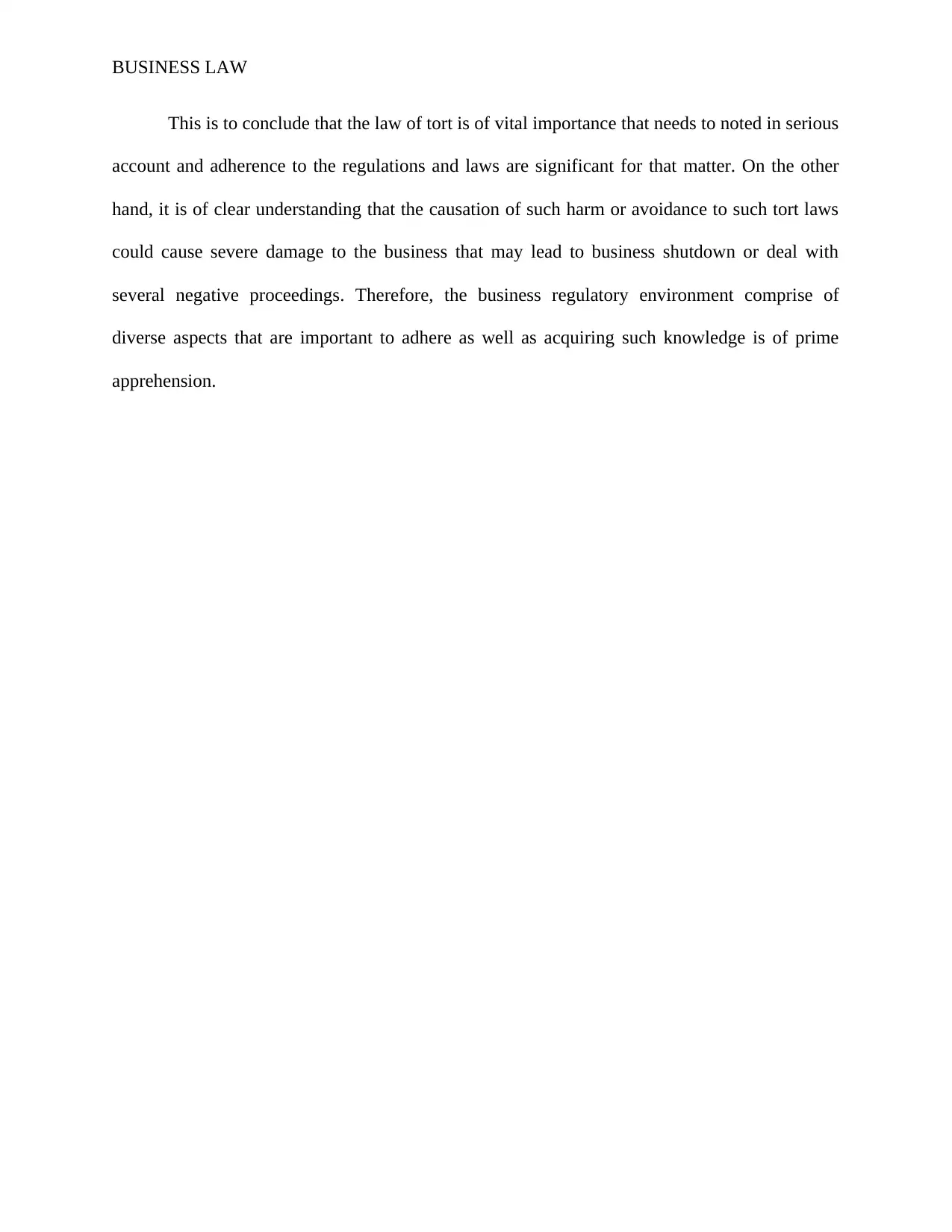
BUSINESS LAW
This is to conclude that the law of tort is of vital importance that needs to noted in serious
account and adherence to the regulations and laws are significant for that matter. On the other
hand, it is of clear understanding that the causation of such harm or avoidance to such tort laws
could cause severe damage to the business that may lead to business shutdown or deal with
several negative proceedings. Therefore, the business regulatory environment comprise of
diverse aspects that are important to adhere as well as acquiring such knowledge is of prime
apprehension.
This is to conclude that the law of tort is of vital importance that needs to noted in serious
account and adherence to the regulations and laws are significant for that matter. On the other
hand, it is of clear understanding that the causation of such harm or avoidance to such tort laws
could cause severe damage to the business that may lead to business shutdown or deal with
several negative proceedings. Therefore, the business regulatory environment comprise of
diverse aspects that are important to adhere as well as acquiring such knowledge is of prime
apprehension.
⊘ This is a preview!⊘
Do you want full access?
Subscribe today to unlock all pages.

Trusted by 1+ million students worldwide

BUSINESS LAW
References
Abraham, K., 2017. The forms and functions of tort law. West Academic.
Accc.gov.au (2017). Compliance & enforcement policy. [online] Australian Competition and
Consumer Commission. Available at: https://www.accc.gov.au/about-us/australian-competition-
consumer-commission/compliance-enforcement-policy [Accessed 12 Sep. 2017].
Arlen, J., 2017. Economics of Tort Law. The Oxford Handbook of Law and Economics: Volume
2: Private and Commercial Law, p.41.
Cane, P., 2017. Key Ideas in Tort Law. Bloomsbury Publishing.
Fennell, L.A., 2017. Lumps and Lapses in Tort Law.
Goh, Y. and Yip, M., 2017. Concurrent Liability in Tort and Contract: An Analysis of Interplay,
Intersection and Independence.
Hall, G.J., 2017. The Democratic Standard of Care in Tort Law.
Heaton, P., 2017. How Does Tort Law Affect Consumer Auto Insurance Costs?. Journal of Risk
and Insurance, 84(2), pp.691-715.
Henderson, J.A., Kysar, D.A. and Pearson, R.N., 2017. The torts process. Wolters Kluwer Law
& Business.
Hershovitz, S., 2017. The Search for a Grand Unified Theory of Tort Law.
Robinette, C., Coleman, J., Geistfeld, M., Goldberg, J.C., Perry, R., Sharkey, C., Witt, J. and
Zipursky, B., 2017. JOuRNal Of TORT law.
References
Abraham, K., 2017. The forms and functions of tort law. West Academic.
Accc.gov.au (2017). Compliance & enforcement policy. [online] Australian Competition and
Consumer Commission. Available at: https://www.accc.gov.au/about-us/australian-competition-
consumer-commission/compliance-enforcement-policy [Accessed 12 Sep. 2017].
Arlen, J., 2017. Economics of Tort Law. The Oxford Handbook of Law and Economics: Volume
2: Private and Commercial Law, p.41.
Cane, P., 2017. Key Ideas in Tort Law. Bloomsbury Publishing.
Fennell, L.A., 2017. Lumps and Lapses in Tort Law.
Goh, Y. and Yip, M., 2017. Concurrent Liability in Tort and Contract: An Analysis of Interplay,
Intersection and Independence.
Hall, G.J., 2017. The Democratic Standard of Care in Tort Law.
Heaton, P., 2017. How Does Tort Law Affect Consumer Auto Insurance Costs?. Journal of Risk
and Insurance, 84(2), pp.691-715.
Henderson, J.A., Kysar, D.A. and Pearson, R.N., 2017. The torts process. Wolters Kluwer Law
& Business.
Hershovitz, S., 2017. The Search for a Grand Unified Theory of Tort Law.
Robinette, C., Coleman, J., Geistfeld, M., Goldberg, J.C., Perry, R., Sharkey, C., Witt, J. and
Zipursky, B., 2017. JOuRNal Of TORT law.
Paraphrase This Document
Need a fresh take? Get an instant paraphrase of this document with our AI Paraphraser
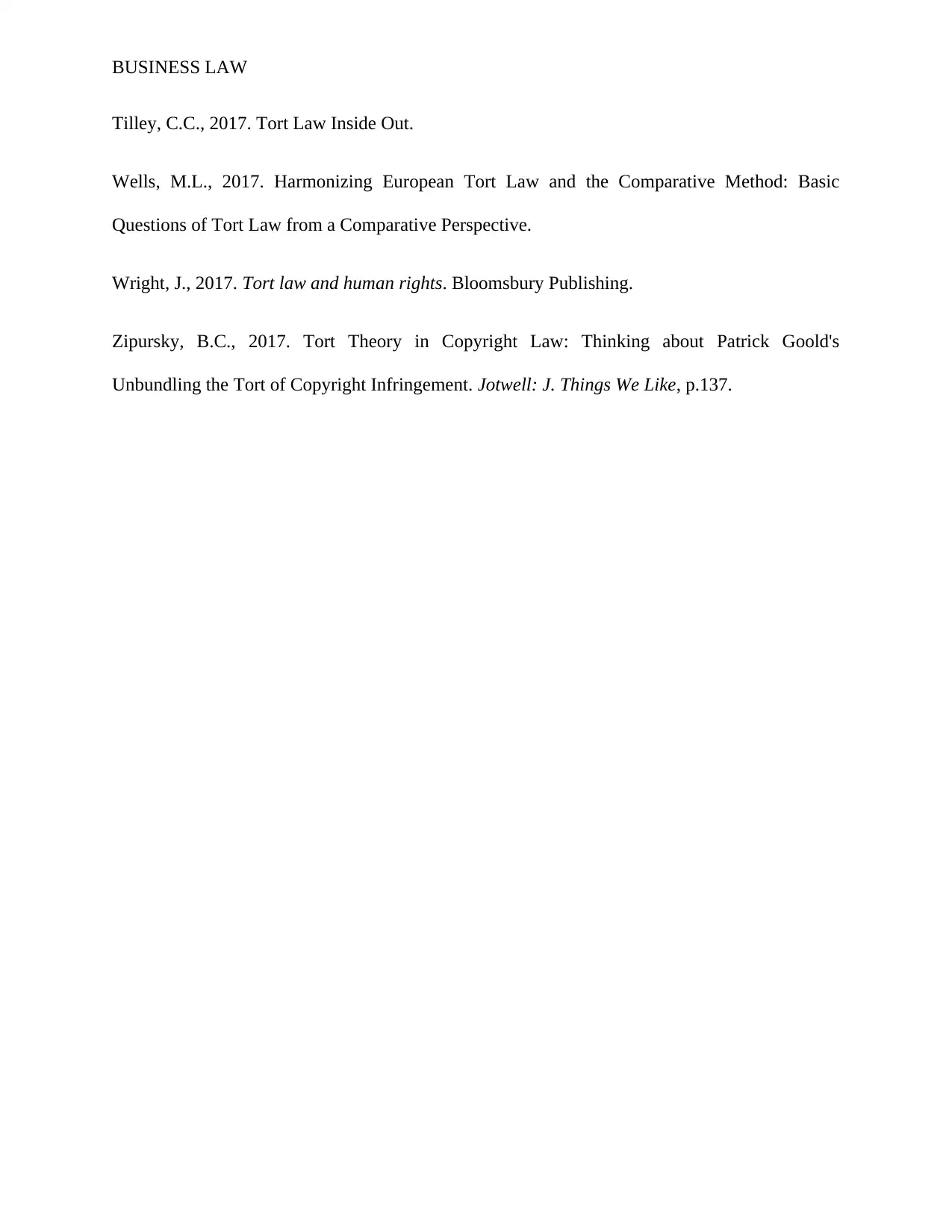
BUSINESS LAW
Tilley, C.C., 2017. Tort Law Inside Out.
Wells, M.L., 2017. Harmonizing European Tort Law and the Comparative Method: Basic
Questions of Tort Law from a Comparative Perspective.
Wright, J., 2017. Tort law and human rights. Bloomsbury Publishing.
Zipursky, B.C., 2017. Tort Theory in Copyright Law: Thinking about Patrick Goold's
Unbundling the Tort of Copyright Infringement. Jotwell: J. Things We Like, p.137.
Tilley, C.C., 2017. Tort Law Inside Out.
Wells, M.L., 2017. Harmonizing European Tort Law and the Comparative Method: Basic
Questions of Tort Law from a Comparative Perspective.
Wright, J., 2017. Tort law and human rights. Bloomsbury Publishing.
Zipursky, B.C., 2017. Tort Theory in Copyright Law: Thinking about Patrick Goold's
Unbundling the Tort of Copyright Infringement. Jotwell: J. Things We Like, p.137.
1 out of 11
Related Documents
Your All-in-One AI-Powered Toolkit for Academic Success.
+13062052269
info@desklib.com
Available 24*7 on WhatsApp / Email
![[object Object]](/_next/static/media/star-bottom.7253800d.svg)
Unlock your academic potential
Copyright © 2020–2025 A2Z Services. All Rights Reserved. Developed and managed by ZUCOL.




